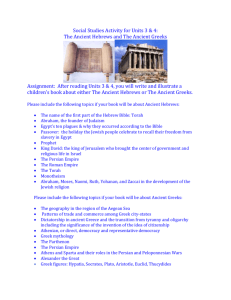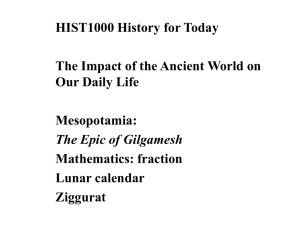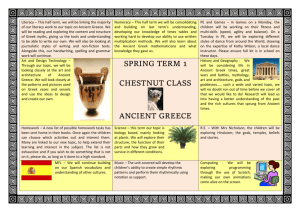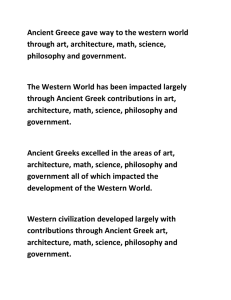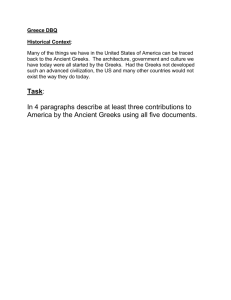Block Outcomes - Hamilton Trust
advertisement
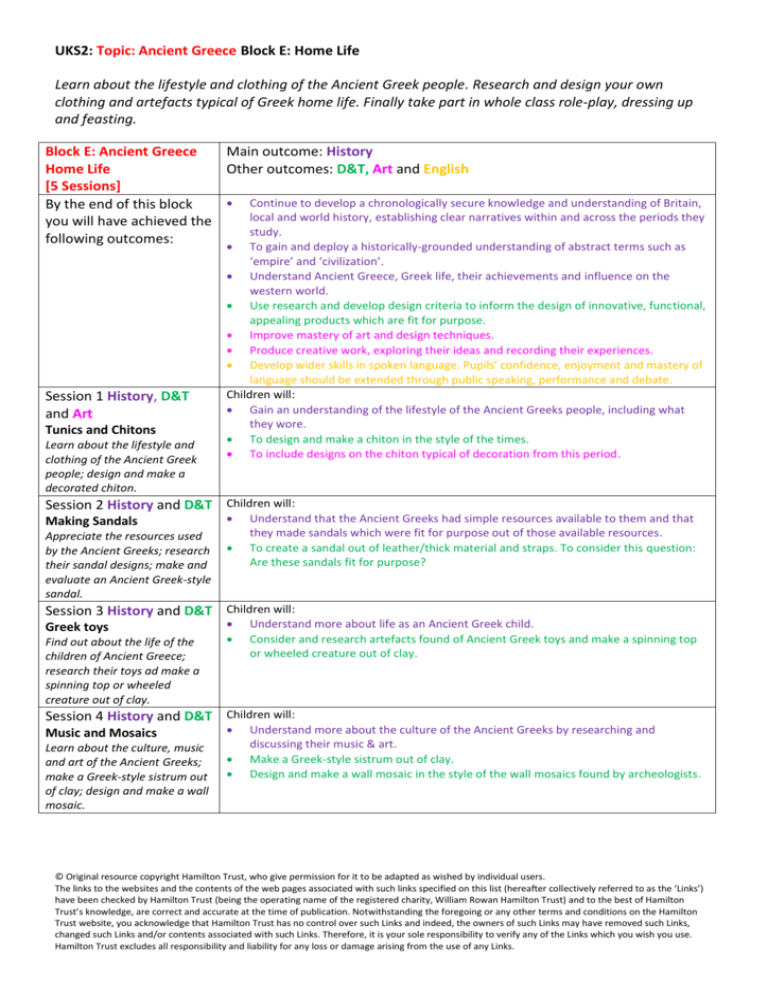
UKS2: Topic: Ancient Greece Block E: Home Life Learn about the lifestyle and clothing of the Ancient Greek people. Research and design your own clothing and artefacts typical of Greek home life. Finally take part in whole class role-play, dressing up and feasting. Block E: Ancient Greece Main outcome: History Home Life Other outcomes: D&T, Art and English [5 Sessions] Continue to develop a chronologically secure knowledge and understanding of Britain, By the end of this block local and world history, establishing clear narratives within and across the periods they you will have achieved the study. following outcomes: Session 1 History, D&T and Art Tunics and Chitons Learn about the lifestyle and clothing of the Ancient Greek people; design and make a decorated chiton. To gain and deploy a historically-grounded understanding of abstract terms such as ‘empire’ and ‘civilization’. Understand Ancient Greece, Greek life, their achievements and influence on the western world. Use research and develop design criteria to inform the design of innovative, functional, appealing products which are fit for purpose. Improve mastery of art and design techniques. Produce creative work, exploring their ideas and recording their experiences. Develop wider skills in spoken language. Pupils’ confidence, enjoyment and mastery of language should be extended through public speaking, performance and debate. Children will: Gain an understanding of the lifestyle of the Ancient Greeks people, including what they wore. To design and make a chiton in the style of the times. To include designs on the chiton typical of decoration from this period. Session 2 History and D&T Children will: Making Sandals Appreciate the resources used by the Ancient Greeks; research their sandal designs; make and evaluate an Ancient Greek-style sandal. Understand that the Ancient Greeks had simple resources available to them and that they made sandals which were fit for purpose out of those available resources. To create a sandal out of leather/thick material and straps. To consider this question: Are these sandals fit for purpose? Session 3 History and D&T Children will: Greek toys Find out about the life of the children of Ancient Greece; research their toys ad make a spinning top or wheeled creature out of clay. Understand more about life as an Ancient Greek child. Consider and research artefacts found of Ancient Greek toys and make a spinning top or wheeled creature out of clay. Session 4 History and D&T Children will: Music and Mosaics Learn about the culture, music and art of the Ancient Greeks; make a Greek-style sistrum out of clay; design and make a wall mosaic. Understand more about the culture of the Ancient Greeks by researching and discussing their music & art. Make a Greek-style sistrum out of clay. Design and make a wall mosaic in the style of the wall mosaics found by archeologists. © Original resource copyright Hamilton Trust, who give permission for it to be adapted as wished by individual users. The links to the websites and the contents of the web pages associated with such links specified on this list (hereafter collectively referred to as the ‘Links’) have been checked by Hamilton Trust (being the operating name of the registered charity, William Rowan Hamilton Trust) and to the best of Hamilton Trust’s knowledge, are correct and accurate at the time of publication. Notwithstanding the foregoing or any other terms and conditions on the Hamilton Trust website, you acknowledge that Hamilton Trust has no control over such Links and indeed, the owners of such Links may have removed such Links, changed such Links and/or contents associated with such Links. Therefore, it is your sole responsibility to verify any of the Links which you wish you use. Hamilton Trust excludes all responsibility and liability for any loss or damage arising from the use of any Links. UKS2: Topic: Ancient Greece Block E: Home Life Session 5 History, D&T and English Greek Feast! Discover the food and cooking of the Ancient Greeks; make food typical of the Ancient Greeks; take part in whole class role-play, dressing up and feasting. Children will: Understand what food the Ancient Greeks would have eaten and the processes involved in making it. Consider why they ate these foods and what ingredients were available to them at the time. Make food typical of the Ancient Greeks. Express daily life of the Ancient Greeks through whole class role-play, dressing up and feasting. Resources Session 1 Provided: Presentation on How to make a chiton. You will need: Access to the Internet; A large rectangular piece of fabric (bed sheet), Safety pins, a thin belt or rope, Gold ribbon or shiny material, fabric glue, permanent markers or fabric pens (black), Ancient Greek finger food (olives ,bread, grapes, blocks of cheese). Session 2 Provided: Presentation on How to make an Ancient Greek sandal. You will need: Access to the Internet; Squares of leather or thick material (or a piece of car mat/foam), strips of leather, cord or thick (non-fraying) material, leather hole punch, strong scissors, paper and felt tip. Session 3 Provided: Presentations on Ancient Greek toys & How to make Ancient Greek toys. You will need: Access to the Internet; Terracotta clay, bolster wood rods or thin wooden stick. Session 4 Provided: Presentations covering: Ancient Greek musical instruments and mosaics & How to make Ancient Greek musical instruments and mosaics. You will need: Access to the Internet; A surface to mosaic (old vase, jam jar, old coaster or square of thick card or wood), squares of coloured card, scissors, PVA glue, paint brush, terracotta clay, small wooden rods or long spent matchsticks. Session 5 Provided: Presentation on Preparing Ancient Greek food for guests. You will need: Access to the Internet; Chiton from Session 1; Sandals from Session 2; Home-made toy from Session 3; Mosaic or musical instrument created in Session 4. Ingredients and fresh herbs for Ancient Greek food, oven and cooking utensils. © Original resource copyright Hamilton Trust, who give permission for it to be adapted as wished by individual users. The links to the websites and the contents of the web pages associated with such links specified on this list (hereafter collectively referred to as the ‘Links’) have been checked by Hamilton Trust (being the operating name of the registered charity, William Rowan Hamilton Trust) and to the best of Hamilton Trust’s knowledge, are correct and accurate at the time of publication. Notwithstanding the foregoing or any other terms and conditions on the Hamilton Trust website, you acknowledge that Hamilton Trust has no control over such Links and indeed, the owners of such Links may have removed such Links, changed such Links and/or contents associated with such Links. Therefore, it is your sole responsibility to verify any of the Links which you wish you use. Hamilton Trust excludes all responsibility and liability for any loss or damage arising from the use of any Links.
